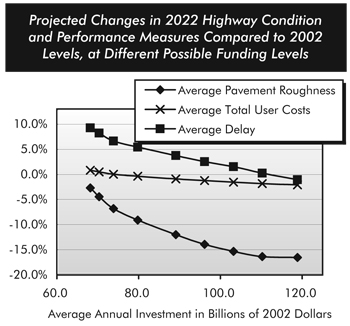
Impacts of Investment: Highway and Bridge
Linkage Between Recent Condition and Performance Trends and Recent Spending Trends
Spending by all levels of government on system preservation increased by 56 percent between 1997 and 2002, from $23.0 to $35.8 billion. This increased investment in roadway and bridge rehabilitation and resurfacing is reflected in the improvements in pavement ride quality and reductions in bridge deficiencies that are described elsewhere in this report.
Investment in system expansion has also increased, but at a much lower rate relative to outlays for system preservation. While the rate of deterioration in various measures of operational performance has decreased, the level of investment has not stopped the overall growth in congestion levels.
Impact of Future Investment on Highway Conditions and Performance
If average annual highway capital investment from 2003 to 2022 reaches the projected $118.9 billion Maximum Economic Investment level and is applied in the manner suggested by the analysis, shifting more investment toward system expansion to address increasing congestion problems, average pavement quality is projected to improve by 16.7 percent relative to year 2002 levels. Improvements in highway operational performance would cause average delay to decrease by 1.0 percent, while average highway user costs would decline by 2.1 percent. [Note these delay figures reflect average delay per vehicle miles traveled (VMT); total delay would be expected to increase as total VMT rises over time.]
If all levels of government combined invested at the Cost To Maintain projected level of $73.8 billion, and slightly increased the share of investment devoted to system preservation as suggested by the analysis, average pavement roughness would improve by 6.8 percent, while average delay would worsen by 6.6 percent. By definition, average highway user costs would remain at year 2002 levels.

Impact of Investment on Travel Growth
The amount of travel growth on a highway segment may be affected by the level of investment on that segment. Investments that reduce the economic cost of using the facility will tend to encourage additional use, while increasing congestion on an unimproved roadway can cause travel growth to be lower than it otherwise would be. The travel growth forecasts used in the analysis of highway investment requirements in this report are dynamic, in the sense that they allow feedback between the level of future investment and future VMT growth.
If highway-user costs are maintained at current levels as they would be under the Cost to Maintain scenario, the analysis projects that urban VMT would grow by an average annual rate of 1.97 percent. If highway-user costs decline, as they would under the Maximum Economic Investment scenario, this rate would increase to 2.12 percent per year.
Impact of Investment on Travel Growth
The amount of travel growth on a highway segment may be affected by the level of investment on that segment. Investments that reduce the economic cost of using the facility will tend to encourage additional use, while increasing congestion on an unimproved roadway can cause travel growth to be lower than it otherwise would be. The travel growth forecasts used in the analysis of highway investment requirements in this report are dynamic, in the sense that they allow feedback between the level of future investment and future VMT growth.
If highway-user costs are maintained at current levels as they would be under the Cost to Maintain scenario, the analysis projects that urban VMT would grow by an average annual rate of 1.97 percent. If highway-user costs decline, as they would under the Maximum Economic Investment scenario, this rate would increase to 2.12 percent per year.

